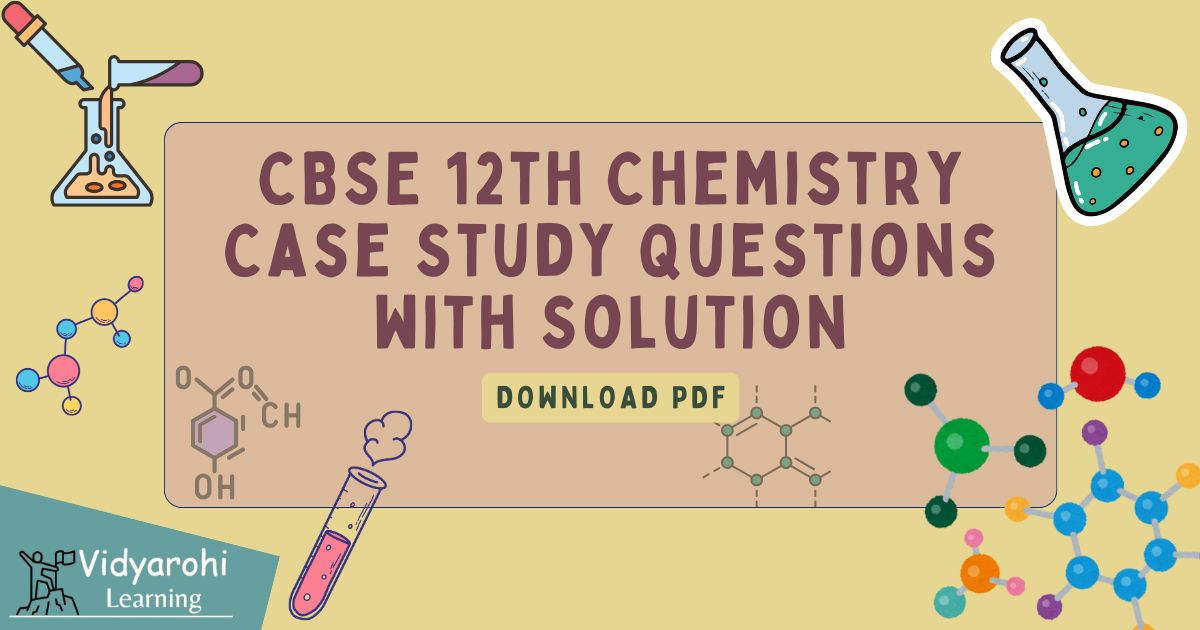CBSE 12th Chemistry Case Study Questions: In recent years, CBSE has introduced case study questions in Class 12 board exams to make learning more practical and meaningful. Instead of just testing memory and formulas, CBSE Class 12 Chemistry Case Study Questions check how well students can apply concepts to real-life situations. This approach helps students think critically, analyse information, and develop problem-solving skills. It also prepares them for competitive exams and higher studies by focusing on understanding rather than rote learning. For the academic year 2025-26, CBSE Class 12 Chemistry exam, Case Study Questions will continue to be an important part of the paper because they check analytical thinking and problem-solving skills. This article explains what Class 12 Chemistry Case Study Questions are, their format, examples, and how to prepare for them. It will help you understand concepts better, study smartly, and feel more confident during the exams.
Also check,
What are CBSE Class 12 Chemistry Case Study Questions?
CBSE Class 12 Chemistry Case Study Questions aren’t just about theory or concepts. They aim to bridge the gap between classroom learning and real-life applications. As CBSE continues to focus on competency-based assessments, these case study questions are expected to become even more important in future exams.
Case Study Questions are a type of competency-based question designed to test a student’s ability to:
- Check how well students can use theories, reactions, and principles in practical contexts.
- Assess the ability to interpret data, graphs, and experimental results.
- Solve problems based on application and reasoning
Instead of direct numerical problems, these questions come with a short passage, situation, or case, followed by 3 objective or subjective questions related to that case.
Also check,
CBSE Class 12 Chemistry Case Study Question Format
According to the CBSE Class 12 Chemistry Paper Design 2025, the paper includes:
- 2 Case study-based questions, carrying 4 marks each.
- In Section D of the question paper
- One case study question has one MCQ of 1 mark, two questions of 1 and 2 marks with one internal choice.
- The other case study question will have three descriptive questions of 2, 1 and 1 mark each, with one internal choice.
These questions require students to understand the given case, extract relevant information, and solve accordingly.
Chapters for Class 12 Chemistry Case Study Questions
CBSE tends to pick case-based questions from chapters that lend themselves to real-world applications. Chapters from which Class 12 Case Study Questions that are commonly asked are listed below:
- Solid State: Types of solids, unit cells, packing efficiency, and defects.
- Solutions: Concentration terms, colligative properties, Raoult’s Law.
- Electrochemistry: Electrochemical cells, Nernst equation, conductance.
- Chemical Kinetics: Rate laws, order of reaction, activation energy.
- Surface Chemistry: Adsorption, catalysts, and colloids.
- Coordination Compounds: Nomenclature, bonding theories, and isomerism.
- Haloalkanes and Haloarenes: Properties, reactions, and mechanisms.
- Alcohols, Phenols and Ethers: Preparation, properties, and uses.
- Aldehydes, Ketones and Carboxylic Acids: Nucleophilic addition, oxidation, reduction.
Importance of Case Study Questions in Class 12 Chemistry
Case study questions in Class 12 Chemistry are an important part of the CBSE Board Exam. They are designed to test not just theoretical knowledge but also the ability to apply concepts to real-life situations. These questions push students to think critically, analyse data, and develop problem-solving skills rather than simply memorising formulas. By practising case study questions, students gain a deeper understanding of Chemistry concepts and improve their exam performance. They also help reduce exam fear because students learn how to approach different types of problems with confidence.
- Encourages students to apply theoretical concepts to practical situations, understand experimental outcomes and real-life scenarios.
- Improves the ability to analyse data, graphs, and case-based situations logically.
- Enhances skills needed to solve multi-concept and integrated questions.
- Help students understand the utility of Chemistry in daily life
- Helps students understand concepts deeply instead of rote learning.
Also chekc,
Tips to Solve Chemistry Case Study Questions Effectively
To solve Chemistry case study questions effectively, first read the question carefully and understand the real-life situation given. Identify the Chemistry concepts or formulas needed to solve it. Break the problem into small parts and solve it step by step. Practice similar questions regularly to improve speed and accuracy. Here are some expert tips for solving Class 12th Chemistry Case Study Questions effectively:
1. Read the Case Carefully: Take time to understand the situation, data, and what exactly is being asked before attempting.
2. Identify the Chapter and Concept: Match the scenario with the Chemistry chapter or topic it belongs to (e.g., Electrochemistry, Organic Chemistry, etc.).
3. Highlight Key Data: Underline important numbers, reactions, or keywords to avoid confusion.
4. Break Down the Problem: Treat each sub-question individually. Don’t get overwhelmed by the case’s length; they are often easier than they look!
5. Draw Diagrams or Sketches: Sketching a simple diagram can make the problem clearer and help you visualise the concept.
6. Use Formulas Appropriately: Pick the correct formula and substitute values carefully to avoid calculation mistakes.
7. Use Correct Formulas and Reactions: Double-check formulas, reaction mechanisms, and units before solving.
8. Write Clear, Short Answers: Keep your explanation simple and to the point to save time.
9. Practice from Sample Papers and Past Year Papers: Use the CBSE Sample Paper 2025 and previous years’ board papers to practice similar case-based questions.
CBSE Class 12 Chemistry Case Study Question
Let’s look at an example to understand how these questions appear:
Case No.1: In general, there are two types of protein molecules: fibrous proteins and globular proteins. Fibrous proteins are insoluble and elongated. Globular proteins are soluble and compact. Fibrous and Globular proteins may comprise one or more types of protein structures, and they include primary, secondary, tertiary and quaternary structures. These structures are based on the level of complexity of the folding of a polypeptide chain.
Primary Structure: It is a specific sequence of amino acids. The order of amino acids bonded together is detected by information stored in genes.
Secondary Structure: It is the shape in which a long polypeptide chain can exist. It is formed by hydrogen bonds between the atoms along the backbone of the polypeptide chain.
Tertiary Structure: It is determined by R-groups. It is a three-dimensional shape of a protein. Many numbers of tertiary structure fold to form quaternary Structure.
Quaternary Structure: It is the arrangement of multiple folded protein subunits in a multi-subunit complex.
The following questions are multiple-choice questions. Choose the most appropriate answer:
(i) Beta-pleated sheets are an example of:
a) Primary Structure
b) Secondary Structure
c) Tertiary Structure
d) Quaternary Structure
Answer: b) Secondary Structure
(ii) Which of the following structures have hydrogen bonds between polypeptide chains arranged in parallel?
a) Primary structure
b) Alpha-helix structure
c) Beta-Pleated sheets
d) Tertiary structure
Answer: c) Beta-Pleated sheets
(iii) Which of the following statements are true about proteins?
a) Proteins are made up of amino acids.
b) Proteins are essential for the development of skin, teeth and bones.
c) Protein is the only nutrient that can build, repair and maintain body tissues.
d) All of the above
Answer: d) All of the above
(iv) What is a bond between amino acids called?
a) Ionic Bond
b) Peptide Bond
c) Hydrogen bond
d) Acidic bond
Answer: b) Peptide Bond
(v) A tripeptide has :
a) 3 amino acids and 1 peptide bond
b) 3 amino acids and 2 peptide bonds
c) 3 amino acids and 3 peptide bonds
d) 3 amino acids and 4 peptide bonds
Answer: b) 3 amino acids and 2 peptide bonds
Case No.2: In the hexagonal system of crystals, the arrangement of atoms is described as a hexagonal prism. In this, the top and bottom of the cell are arranged in regular hexagons along with the three atoms that are sandwiched in between them. The total number of atoms per unit cell in hcp is six. So, hexagonal close packing (hcp), is constituted of a sphere on a flat surface, which is hence surrounded in the same plane by the six identical spheres which are very close to each other. Three spheres are then placed over the first layer so that they touch each other which eventually represents the second layer. Each one of these three spheres touches three spheres of the bottom layer. Finally, the second layer is covered with a third layer that is identical to the bottom layer in relative position. Since the structure repeats itself after every two
layers, the stacking for hcp may be described as "ABAB.." The atoms in a hexagonal closest-packed structure efficiently occupy 74% of space.
Based on the above information, answer the following questions:
(i) Which of the following types of arrangement is present in hcp crystal structure?
(a) AAAA....
(b) ABAB...
(c) ABCABC....
(d) None of the above
Answer: (b) ABAB...
(ii) How much empty space is present in the hcp unit cell?
(a) 74%
(b) 47.6%
(c) 32%
(d) 26%
Answer: (d) 26%
(iii) Which of the following statements is correct about hexagonal close packing?
(a) In this arrangement, the second layer is identical to the first layer.
(b) The total number of atoms per unit cell is 6.
(c) It is as closely packed as body-centred cubic packing.
(d) Its packing efficiency is 68%.
Answer: (b) The total number of atoms per unit cell is 6.
Q.No.3: Read the passage given below and answer the following questions:
Aliphatic amines with low molecular masses are gases and have a fishy smell. Primary amines consisting of at least three carbon atoms exist in a liquid state whereas the higher ones are solid. Many aryl amines, including aniline, are colourless, but they show colour on atmospheric oxidation. Lower aliphatic amines form hydrogen bonds with water due to which they are soluble in water. Whereas the higher amines are insoluble in water due to the large size of the hydrophobic alkyl part. Considering the electronegativity of nitrogen of amine and oxygen of alcohol as 3.0 and 3.5, respectively, it can be anticipated that amines show lower solubility in water as compared to alcohols. The decreasing order of hydrogen bonding in amines is as follows:
Primary > Secondary > Tertiary
(i) What is the order of boiling points of isomeric amines?
(ii) Which class of amines have a fishy odour?
(iii) Why are higher amines insoluble in water?
(iv) Why is the intermolecular association more in primary amines than in secondary amines?
(v) Alcohols of comparable molecular masses have a higher boiling point than amines. Explain
Answer:
(i) The order of boiling points of isomeric amines is as follows:
Primary > Secondary > Tertiary
(ii) The lower aliphatic amines are gases with a fishy odour.
(iii) Solubility decreases with an increase in the molar mass of amines due to an increase in the size of the hydrophobic alkyl part. Therefore, higher amines are essentially insoluble in water.
(iv) The intermolecular association is more in primary amines than in secondary amines because there are two hydrogen atoms available for hydrogen bond formation in it.
(v) The electronegativity of oxygen in alcohol is more than that of nitrogen amine. Thus, alcohols are more polar than amines and form stronger intermolecular hydrogen bonds than amines. Hence, the boiling points of alcohols of comparable molecular masses are higher than amines.
CBSE Class 12 Chemistry Case Study Question PDF [Free]
Click on the link provided below to download the CBSE Class 12 Chemistry Case Study Question PDF with answers for free without any login. Get the direct link to download the PDF.
| CBSE Class 12 Chemistry Case Study Question PDF | Download here |
| CBSE Class 12 Chemistry Case Study Question- Solution PDF | Download here |
Common Mistakes to Avoid In Chemistry Case Study Questions
- Skipping the passage: Students often directly jump to the question without understanding the context.
- Ignoring Units and Conversions: Forgetting to convert values into the same units (like mL to L or atm to Pa) results in calculation errors.
- Mixing Up Concepts: Applying formulas or reactions from the wrong chapter (e.g., using kinetics instead of thermodynamics).
- Memorising Without Understanding: Trying to rote-learn reactions instead of understanding the mechanism leads to confusion.
- Misinterpreting the case: Especially in word problems involving diagrams or figures.
- Not revising key formulas: Weak formula recall can ruin your answer.
- Lack of practice: These questions are relatively new, and many students aren’t used to them yet.
CBSE Class 12 Chemistry Syllabus 2025-26
The Central Board of Secondary Education (CBSE) has released the Chemistry Syllabus for Class 12 Science streams for the 2025-26 academic year. This Chemistry Syllabus outlines the course structure, chapters, and topics that students will need to study in the subject. The CBSE Class 12 Chemistry syllabus covers a wide range of topics, including Electrostatics, Current Electricity, Magnetic Effects of Current and Magnetism, Electromagnetic Induction and Alternating Currents, Electromagnetic Waves, Optics, Dual Nature of Radiation and Matter, Atoms and Nuclei, and Electronic Devices. It is divided into units with specific weightage, helping students plan their preparation effectively. The unit-wise chapters and weightage are provided below:
| Unit Name | Marks |
| Solutions | 7 |
| Electrochemistry | 9 |
| Chemical Kinetics | 7 |
| d and f -Block Elements | 7 |
| Coordination Compounds | 7 |
| Haloalkanes and Haloarenes | 6 |
| Alcohols, Phenols and Ethers | 6 |
| Aldehydes, Ketones and Carboxylic Acids | 8 |
| Amines | 6 |
| Biomolecules | 7 |
| Total | 70 |
Check the latest and detailed CBSE Class 12 Chemistry Syllabus 2025-26; Check Latest Unit-wise Weightage, Download PDF
CBSE Class 12 Chemistry Exam Pattern 2025-26
CBSE has released the exam pattern and marking scheme for the 2025-26 academic year. Based on the official question paper design shared along with the syllabus, the board will follow the same exam pattern and marking scheme as in 2024-25. The CBSE Class 12 Chemistry board exam for 2025-26 will consist of a theory paper of 70 marks, and 30 marks are assigned to the practical exam. The question paper was divided into five different sections:
| Section | Question Type | Number of Questions | Marks |
| A | Multiple Choice Questions & Assertion and Reason Questions (1 mark) | 16 | 16 |
| B | Very Short Answer (2 mark) | 5 | 10 |
| C | Short Answer (3 marks) | 7 | 21 |
| D | Case Study-Based Questions (4 marks) | 2 | 8 |
| E | Long Answer (5 marks) | 3 | 15 |
| Total | 33 | 80 | |
Check the latest and detailed CBSE Class 12th Chemistry Exam Pattern 2025-26 with Marking Scheme.


